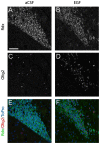EGF-induced expansion of migratory cells in the rostral migratory stream
- PMID: 23029503
- PMCID: PMC3460866
- DOI: 10.1371/journal.pone.0046380
EGF-induced expansion of migratory cells in the rostral migratory stream
Abstract
The presence of neural stem cells in the adult brain is currently widely accepted and efforts are made to harness the regenerative potential of these cells. The dentate gyrus of the hippocampal formation, and the subventricular zone (SVZ) of the anterior lateral ventricles, are considered the main loci of adult neurogenesis. The rostral migratory stream (RMS) is the structure funneling SVZ progenitor cells through the forebrain to their final destination in the olfactory bulb. Moreover, extensive proliferation occurs in the RMS. Some evidence suggest the presence of stem cells in the RMS, but these cells are few and possibly of limited differentiation potential. We have recently demonstrated the specific expression of the cytoskeleton linker protein radixin in neuroblasts in the RMS and in oligodendrocyte progenitors throughout the brain. These cell populations are greatly altered after intracerebroventricular infusion of epidermal growth factor (EGF). In the current study we investigate the effect of EGF infusion on the rat RMS. We describe a specific increase of radixin(+)/Olig2(+) cells in the RMS. Negative for NG2 and CNPase, these radixin(+)/Olig2(+) cells are distinct from typical oligodendrocyte progenitors. The expanded Olig2(+) population responds rapidly to EGF and proliferates after only 24 hours along the entire RMS, suggesting local activation by EGF throughout the RMS rather than migration from the SVZ. In addition, the radixin(+)/Olig2(+) progenitors assemble in chains in vivo and migrate in chains in explant cultures, suggesting that they possess migratory properties within the RMS. In summary, these results provide insight into the adaptive capacity of the RMS and point to an additional stem cell source for future brain repair strategies.
Conflict of interest statement
Figures











Similar articles
-
Expression of ezrin radixin moesin proteins in the adult subventricular zone and the rostral migratory stream.Neuroscience. 2010 May 5;167(2):312-22. doi: 10.1016/j.neuroscience.2010.01.035. Epub 2010 Jan 28. Neuroscience. 2010. PMID: 20109539
-
Morphological and Cellular Characterization of the Fetal Canine (Canis lupus familiaris) Subventricular Zone, Rostral Migratory Stream, and Olfactory Bulb.Anat Rec (Hoboken). 2018 Sep;301(9):1570-1584. doi: 10.1002/ar.23855. Epub 2018 Jul 2. Anat Rec (Hoboken). 2018. PMID: 29752870
-
Involvement of Ngn2, Tbr and NeuroD proteins during postnatal olfactory bulb neurogenesis.Eur J Neurosci. 2009 Jan;29(2):232-43. doi: 10.1111/j.1460-9568.2008.06595.x. Eur J Neurosci. 2009. PMID: 19200230
-
Dynamic changes in the transcriptional profile of subventricular zone-derived postnatally born neuroblasts.Mech Dev. 2013 Jun-Aug;130(6-8):424-32. doi: 10.1016/j.mod.2012.11.003. Epub 2012 Dec 5. Mech Dev. 2013. PMID: 23220001 Review.
-
Regulation of subventricular zone-derived cells migration in the adult brain.Adv Exp Med Biol. 2015;853:1-21. doi: 10.1007/978-3-319-16537-0_1. Adv Exp Med Biol. 2015. PMID: 25895704 Review.
Cited by
-
Epidermal growth factor treatment of the adult brain subventricular zone leads to focal microglia/macrophage accumulation and angiogenesis.Stem Cell Reports. 2014 Mar 27;2(4):440-8. doi: 10.1016/j.stemcr.2014.02.003. eCollection 2014 Apr 8. Stem Cell Reports. 2014. PMID: 24749069 Free PMC article.
-
A neurocentric perspective on glioma invasion.Nat Rev Neurosci. 2014 Jul;15(7):455-65. doi: 10.1038/nrn3765. Nat Rev Neurosci. 2014. PMID: 24946761 Free PMC article. Review.
-
Glioma Stem Cells: Signaling, Microenvironment, and Therapy.Stem Cells Int. 2016;2016:7849890. doi: 10.1155/2016/7849890. Epub 2016 Jan 6. Stem Cells Int. 2016. PMID: 26880988 Free PMC article. Review.
-
Secretagogin-dependent matrix metalloprotease-2 release from neurons regulates neuroblast migration.Proc Natl Acad Sci U S A. 2017 Mar 7;114(10):E2006-E2015. doi: 10.1073/pnas.1700662114. Epub 2017 Feb 21. Proc Natl Acad Sci U S A. 2017. PMID: 28223495 Free PMC article.
-
Visualization of Rostral Migratory Stream in the Developing Rat Brain by In Vivo Electroporation.Cell Mol Neurobiol. 2018 Jul;38(5):1067-1079. doi: 10.1007/s10571-018-0577-6. Epub 2018 Feb 13. Cell Mol Neurobiol. 2018. PMID: 29441488 Free PMC article.
References
-
- Altman J (1969) Autoradiographic and histological studies of postnatal neurogenesis. IV. Cell proliferation and migration in the anterior forebrain, with special reference to persisting neurogenesis in the olfactory bulb. J Comp Neurol 137: 433–457. - PubMed
-
- Lois C, Alvarez-Buylla A (1994) Long-distance neuronal migration in the adult mammalian brain. Science 264: 1145–1148. - PubMed
-
- Pencea V, Luskin MB (2003) Prenatal development of the rodent rostral migratory stream. J Comp Neurol 463: 402–418. - PubMed
-
- Peretto P, Giachino C, Aimar P, Fasolo A, Bonfanti L (2005) Chain formation and glial tube assembly in the shift from neonatal to adult subventricular zone of the rodent forebrain. J Comp Neurol 487: 407–427. - PubMed
Publication types
MeSH terms
Substances
LinkOut - more resources
Full Text Sources

